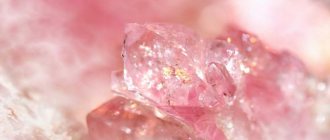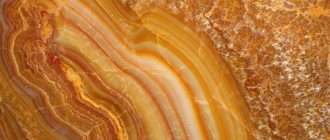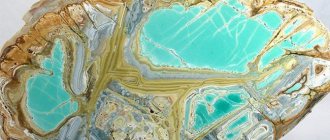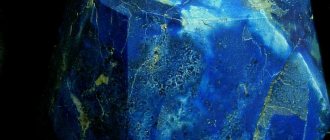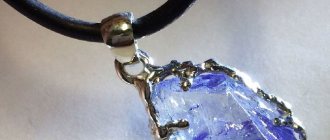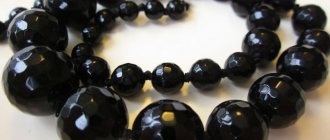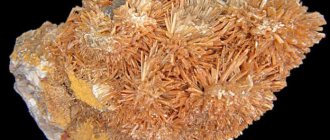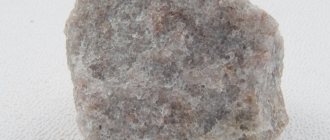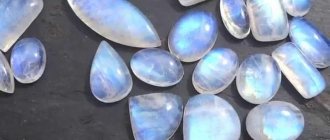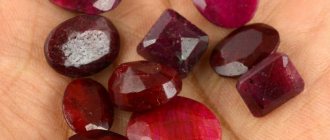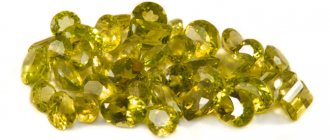Plagioclases are an isomorphic series between sodium-alkaline (albite, analbite, monalbite) and calcium-alkaline earth (P-anorthite, I-anorthite) end members, in which, simultaneously with the replacement of Na by Ca, an equivalent part of Si is replaced by Al. The composition of plagioclase is usually characterized by its number corresponding to the content of the anorthite component (An0-An100).
origin of name
The name of the mineral comes from the Greek “plagios” - oblique, inclined and “oasis” - fracture, emphasizing that the angle between the cleavage planes (001) and (010) is significantly different from straight (from 86°24′ in albite to 86°50′ in anorthitis).
Plagioclase. Adular. The natural intergrowth of crystals is a quadrangle
The English name for plagioclases is Sodium-calcium feldspars (plagioclases)
Plagioclase formula
(Na,Ca)[(Al,Si)4O8]
Varieties
According to the chemical composition, the plagioclase series is traditionally divided into albite (An0-10), oligoclase (An 10-30), andesine (An30-50), labradorite (An 50-7o), bytownite (An10-90) and anorthite (An90-100 ).
Among homogeneous plagioclases, according to their structural state, high-temperature and low-temperature series are distinguished. The crystal structures of the extreme members of the series differ significantly: in albite, NaAlSi3O8. Si and Al are ordered along 4 nonequivalent positions; in anorthite CaAl2Si2O8 they alternate in the Si,Al framework and are strictly ordered, which leads to doubling of the unit cell along the c axis, 7x2=14A (the differences in the high-temperature body-centered structure are determined by the displacement of Ca atoms). In the intermediate members of the series, albite 7 A domains alternate in different proportions with anorthite 14 A domains (the X-ray reflections of the latter, responsible for cell doubling, appear in them as weak satellite reflections). The structure of low-temperature albite is preserved only up to composition An5, expanding the region of oligoclase, which makes it possible to distinguish compositions An5-10 as albite-oligoclases. As in alkali feldspars, phase decomposition phenomena have been established in plagioclases. Three regions of decomposition are distinguished: peristerites (in the region of albite-oligoclase, An2-An15, with the formation of plates with a thickness of X = 1000-5000 A along the (081) plane, close to (010), corresponding in composition to albite and oligoclase An25, sometimes An20-35), the Böggild region (in andesine-labradorite, An48-An58, with the formation of two phases of “e”-plagioclases An45 and An50-60) and the Huttenlocher intergrowth region (in labradorite-bytownite, An10-An90, with the formation of plates X = 125-850 A of “e''-plagioclase An65 and I-anorthite). Structural and subsolidus phase relationships in plagioclases are complex, debatable, and interpreted ambiguously. Decayed plagioclases often exhibit iridescence. Albite-oligoclases and oligoclases with a blue or milky-white pearl tint, by analogy with K,Na-feldspars, are distinguished as moonstones. Blue and blue-green iridescence is characteristic of Labrador. Aventurine albite-oligoclases and labradorite, which exhibit a yellow-orange or, respectively, reddish-pink, crimson tint, are distinguished as sunstones.
Crystallographic characteristics
Syngony. Triclinic
Aggregates. The crystals are the same in appearance as those of potassium feldspars. Plagioclases often form irregular grains embedded in the rock, granular aggregates, sugar-like masses, and sometimes druses (albite). The formation of polysynthetic (multiple repeating) twins is typical - the crystal consists of many very thin (hundredths - tenths of a millimeter) lamellar crystals.
Description of plagioclase
Plagioclase is a mineral that belongs to the rock-forming group. In terms of its chemical composition, it is a continuous isomorphic series of sodium-calcium aluminosilicates - albite and anorthite.
This means that the same mineral contains albite and anorthite, and the hardness of the stone, physical and optical properties depend on the percentage of these substances.
To designate plagioclases, mineralogist Fedorov proposed to classify them according to the presence of an anorthite component. Thus, a mineral with a percentage of anorthite - 72, albite - 28 is called “plagioclase No. 72”.
Moreover, the more anorthite in the composition, the less silicon dioxide, therefore minerals with a number from 0 to 30 are called acidic, from 30 to 50 - medium, from 50 to 100 - basic.
The chemical formula of plagioclase is NaAlSi3O8 – CaAl2Si2O8. The composition contains potassium, barium, iron, and strontium oxide as impurities. In mineralogy, in addition to albite and anorthite, intermediate forms of plagioclase are also distinguished:
- oligoclase;
- andesine;
- Labrador;
- bitovnit.
The mineral got its name from the Greek “breaking”, “splitting”. The main deposits of stone are contact-metamorphic rocks, volcanic rocks, hydrothermal veins, and sedimentary rocks. They are mined in Ukraine, Russia, the USA, Switzerland, Kenya, Zimbabwe, and Madagascar.
The mineral is formed as a result of the crystallization of magma. More than 1 billion years old, as a result of exposure to natural elements it turns into chlorite, kaolin, and mica.
Plagioclase is rarely counterfeited, but is often confused with adularia (moonstone). They are similar in appearance, but the chemical composition is different: adularia is based on potassium, which in plagioclase is only an impurity.
You can distinguish plagioclase:
- by the presence of cracks (can be seen under a magnifying glass, they are quite deep);
- by color and degree of transparency (the stone has warm color tints and a high degree of transparency).
Plastic is used as a counterfeit mineral - in this case you can distinguish:
- by weight (the fake weighs little);
- by the presence of color tints, cracks in the structure, characteristic of the original.
To see what a processed stone looks like:
Physical properties of plagioclases
Optical
- Color white, yellow, pink, green, black. Often colorless. The characteristic colors of iridescence are white, blue, yellowish-white (oligoclase-peristerite, belomorite, labradorite) or golden color caused by inclusions of hematite flakes (aventurine oligoclase, sunstone).
- The line is colorless.
- Glassy shine on cleavage planes. Translucent around the edge.
- Transparency. Transparent or translucent.
Mechanical
- Hardness 6-6.5.
- Density from 2.62 (albite) to 2.76 (anorthite).
- Cleavage according to (001) is perfect, according to (010) clear, according to (110) weakly expressed. The cleavage is perfect in two directions (at an angle of about 860). The angle between the cleavage planes differs from the straight line by 3.5 - 40. The name of the mineral is also associated with this property - from the Greek “plagioclase” - obliquely splitting (unlike potassium feldspars).
- The fracture is stepped, uneven.
- Fragile.
Chemical properties
Unlike all other feldspars (except for Celsian), anorthite dissolves relatively easily in HCl with the formation of gelatin-like silicic acid, bytownite - worse, labradorite - poorly. Albite, oligoclase and andesine dissolve only in HF. All plagioclases are also decomposed by molten soda Na2CO3.
Other properties
IR spectroscopy is used to determine the composition of plagioclases and their thermal history. The characteristic bands are A in the wavelength region 15.4-16.7 mmk and B in the region 18.2-20.0 mmk (in Russia, where frequencies are usually used, this corresponds to m1 = 650-600 cm-1 v2 = 550 -500 cm-1). According to the absorption band v, it depends on the composition of plagioclases, varying from 649 cm-1 in albite to 620 cm-1 in anorthite in the low-temperature series, and on the degree of their order.
Melting points vary from 1100 (albite) to 1550° (anorthite).
Diagnostic signs
The chemical composition of plagioclases can be determined by their refractive indices, which are practically independent of the structural state. The np indicator is diagnostic for the entire plagioclase series, the ng and nm indicators are for plagioclases of composition An 20-100.
The chemical composition and structural state of plagioclases can be determined using the “Slemmons diagram” (with a known composition, the degree of order can be determined and vice versa).
Plagioclases differ from similar potassium feldspars by the mutual arrangement of cleavage planes at an angle of 86 - 870. However, such a slight deviation from the right angle characteristic of potassium feldspars is not visually noticeable. In this regard, it is macroscopically possible to determine only whether the mineral belongs to the feldspar group. In terms of external features, all plagioclases are similar to each other and are usually not separated macroscopically. The only exception is Labradorite - dark gray in color with very characteristic blue iridescence (irridescence) on the cleavage planes
Subgroup of plagioclases
As already indicated, minerals belonging to this subgroup represent a well-studied binary series of isomorphic mixtures, the extreme members of which are called albite - Na
0-10Tricklin. c. OligoclaseIsomorphic mixtures Ab+An10-30>> >>Andesine30-50>> >>Labrador50-70>> >>Bitovnit70-90>> >>Anorthite(An)-Ca[Al2Si2O8]90-100>> >>Plagioclases
— (100-n)Na[AlSi3O8] + nCa[Al2Si2O8], where n varies from 0 to 100. “Plagioclase” translated from Greek means obliquely splitting. Compared to other feldspars, in which the angle between the cleavage planes (001) and (010) is 90° or very close to this figure, in plagioclases it is smaller - 86°24′-86°50′. "Albite" comes from the Latin word "albus", which means "white". “Anorthos” in Greek means oblique (meaning crystallization in the triclinic system).
In view of the exceptional importance of the composition of plagioclases for the systematics of igneous rocks, E. S. Fedorov proposed a very convenient and most rational classification with the designation of each plagioclase by a certain number according to the percentage content of the anorthite molecule in it. For example, plagioclase No. 72 is an isomorphic mixture containing 72% anorthite and 28% albite. In this case, the insignificant isomorphic impurity K[AlSi3O8] is usually neglected.
Sometimes, for general considerations in the taxonomy of igneous rocks, it is convenient to adhere to a rough division of plagioclases according to their composition, namely:
Acid plagioclases No. 0-30 ||-|| medium No. 30-60 ||-|| main no. 60-100
Here the names “acidic”, “medium”, “basic” are not used in the usual sense: they are due to the fact that the content of Si02 (“silicic acid”}> from albite to anorthite gradually decreases; this can be seen from a comparison of the chemical formulas of the end members of this isomorphic row.
Chemical composition
(theoretical) is given in table.
15, which shows the contents of Na2O, CaO, Al2O3 and SiO2 for five numbers of plagioclases. Table 15. Chemical composition and specific gravity of plagioclases
| Compound | Plagioclases | ||||
| № 0 | № 25 | № 50 | № 75 | № 100 | |
| Na2O | 10,79 | 8,84 | 5,89 | 2,92 | — |
| CaO | — | 5,03 | 10,05 | 15,08 | 20,10 |
| Al2O3 | 19,40 | 23,70 | 28,01 | 32,33 | 36,62 |
| SiO2 | 68,81 | 62,43 | 56,05 | 49,67 | 43,28 |
| Ud. weight | 2,624 | 2,643 | 2,669 | 2,705 | 2,758 |
There is almost always an admixture of K2O, sometimes up to several percent. Insignificant impurities of BaO (up to 0.2%), SrO (up to 0.2%), FeO, Fe2O3, and others are also common.
Rice. 349. Albite crystal. The angle between (010) and (001) is 86°24′
singonia
triclinic;
pinacoid c. With. The appearance of crystals
. Well-formed simple crystals are relatively rare. They have a tabular and tabular-prismatic appearance. Their most common form is shown in Fig. 349. Simple twins are rare, but complex polysynthetic twins, also observed in grains of irregular shape, are extremely widespread. They are immediately visible in thin transparent sections when baptized nicols and are so typical that they make it possible to quickly distinguish plagioclases from other minerals.
Aggregates
. Albite in miarolite voids among pegmatites is quite often observed in the form of druses or aggregates, plate-like crystals, sometimes called clevelandite (Fig. 348). There are also granular crystalline rocks consisting almost entirely of plagioclase. These are, for example, sugar-like albite rock, which is often formed metasomatically in pegmatites, anorthosites or labradorites of Ukraine, used as facing stone, etc.
Color
white, grayish-white, sometimes with a greenish, bluish, less often reddish tint.
shine
. The refractive indices naturally increase from albite (Ng = 1.536, Nm = 1.529, Np = 1.525) to anorthite (Ng = 1.588, Nm = 1.583, Np = 1.575).
Varieties
, which received special names due to certain optical effects:
- moonstone
- acidic plagioclase (but more often potassium-sodium feldspar), which has a peculiar soft bluish tint reminiscent of moonlight; - aventurine
or
sunstone
- acidic plagioclase, as well as potassium-sodium feldspar, which has a beautiful sparkling-golden tint caused by inclusions of the finest flakes of iron luster; - labradorite
is the main mineral of the so-called labradorite stone, which is a basic or intermediate plagioclase, often revealing a beautiful iridescent reflection in blue and green tones on the cleavage planes.
Hardness
6-6.5.
The cleavage
is perfect along [001} and {010}.
Ud.
the weight continuously increases from 2.61 (albite) to 2.76 (anorthite).
Diagnostic signs
. In the case of more or less large crystals and grains, plagioclases can be distinguished from similar potassium-sodium feldspars by the oblique angle of their cleavage. However, within a series of plagioclases it is not possible to distinguish different mineral species from each other. Fig. 349. Albite crystal. P. p. tr. melt into glass with difficulty, often turning the flame yellow (Na). They do not dissolve in acids.
Origin
and change.
Plagioclases, the most common of the feldspar group, are present in the vast majority of igneous rocks
. It is characteristic that the composition of plagioclases is in accordance with the degree of basicity of the rock: in basic rocks, i.e., relatively poor in silica (gabbro, basalts, etc.), calcium-rich basic plagioclases are common, usually in association with magnesian-ferruginous silicates; in more acidic igneous rocks (diorites, granites, quartz porphyries, etc.), medium and acid plagioclases are common as rock-forming minerals, often together with potassium-sodium feldspars, quartz, etc.
In pegmatites
, genetically related to granites and, in general, to alkaline intrusive rocks, the most common plagioclase is albite, which develops mostly later metasomatically in the form of fine-grained masses mainly due to potassium-sodium feldspars. Basic plagioclases are known only in rare pegmatites of basic intrusive rocks (gabbro).
During the process of regional metamorphism
During the formation of crystalline schists and veins of the so-called Alpine type, predominantly albite develops (calcium-rich plagioclases are less stable).
When rocks are weathered, plagioclases undergo complete decomposition over time under the influence of soil waters containing CO2, O2, humic acids, etc. Alkalies and alkaline soils are removed.
Practical significance
and
Deposits
. Continuous accumulations of plagioclase due to their low alkali content can rarely be of industrial interest.
Dark gray or almost black labradorites, which have a beautiful blue tint, are used as polished facing stones. They are mined in Zhytomyr
regions in Ukraine. These deposits were accidentally discovered during the construction of a road in 1835. At that time, Labradorite stones were highly valued.
Plagioclases with a lunar tint are known in some pegmatite veins of Shaitanka and Lipovka
(Middle Urals).
Sunstone is usually used for cheap crafts. It is also found in pegmatite veins.
Origin and location
Various: igneous (acidic - in acidic rocks, intermediate - in intermediate rocks, basic - in basic rocks, albite - in alkaline rocks), pegmatite (giant oligoclase segregations are found), hydrothermal (albite only), metamorphic, exogenous - during diagenesis ( albite).
Plagioclases are the main rock-forming minerals of igneous (volcanic and intrusive) rocks, felsic to mafic, metamorphic and metasomatic formations, pegmatites and hydrothermalites. Formed in sedimentary rocks. They are characteristic minerals of the Moon. They are often formed together with potassium, potassium-sodium and barium feldspars. Whether plagioclase belongs to a high-temperature or low-temperature series is determined by the “Slemons diagram”.
Mineral deposits
Plagioclase deposits can be found by the presence of accompanying minerals: pyroxene, magnetite, hornblende. There may also be quartz deposits nearby.
A significant share of plagioclase is supplied from Ukraine. The mineral deposit is located in the Zhytomyr region and has been developed since 1835.
The Labradorite deposit is located in the Republic of North Karelia, which is part of the Russian Federation.
The mineral can also be found in Kamchatka. There is no industrial development of deposits in this region. The stone is of interest only to collectors. They may find small pebbles thrown to the surface by the volcano.
Albit is widespread in Siberia. Its deposits are located in the Urals, Transbaikalia and the Irkutsk region. The mineral is also common in Switzerland. This region produces large stones that are especially prized by collectors.
Plagioclase deposits are also found in Kenya, the USA, Zimbabwe, and Madagascar. Mining of the mineral is carried out in parallel with other rocks.
Mineral Change
Plagioclases in the weathering crust are less stable than potassium feldspars and change before it. Albite is the most stable, calcium plagioclases the least stable. With hypergene alteration of albite-oligoclase and oligoclase, halloysite is formed, after andesine, labradorite and bitownite - montnorillonite, less often halloysite (unlike potassium feldspars, after which kaolinite develops). Halloysite replaces oligoclase without the formation of any intermediate phases, growing on it epitaxically in the same orientation as kaolinite on microcline. Initially, lamellar crystallites of halloysite are formed, from which radiating rays extend from the edges, twisting into tubular crystals typical of halloysite; in each ray, diamond-shaped halloysite layers overlap each other in a tiled manner so that the b axes in them make an angle of 90, or 60, or 30° with the axis of the beam.
In the weathering crust of the gabbro of the Novoburanovsky nickel deposit (Kempirsay ore cluster, North-West Kazakhstan), zonal bauxite nodules were observed, formed during the replacement of bytownite. Directly along the plagioclase rock, a zone of “rice-like” halloysite-10A (rolled tubes with a diameter of 0.05-0.1 microns, a length of 0.2-0.3 microns) of a block-mosaic structure is formed, turning into a gibbsite zone. In the outer parts gibbsite zone, halloysite is again formed in the form of rhomboid plate-shaped new formations of halloysite-7A, turning into spirally twisted tubes (0.2-0.3 μm wide and 3-5 μm long).Successive replacement of bytownite with disordered halloysite-10A, its dissolution and replacement gibbsite, the new formation of ordered halloysite-7A is associated with the neutralization of alkaline (pH ~ 10) solutions and their further acidification.On the island of Pinos, near the city of New Gerona (Cuba), Labradorite (An50-58) quartz monzonite is replaced by gibbsite. Poikilitic rocks are also replaced by gibbsite inclusions of plagioclase in monzonite orthoclase. Labrador weathered gabbro dyke in the Mayari-Baracoa ultramafic massif (Punta Gorda nickel deposit in the Moa region, Orinte Province, Cuba) is replaced mainly by gibbsite, but spherulites (0.1-0.00) are found on the surface of the replaced plagioclase 2 µm) halloysite. The Labradorite of a weathered dyke of amphibolized gabbro at the Sol Libano nickel deposit (Cuba) is replaced by goethite with an admixture of halloysite, while gibbsite is absent here. Labradorite (An41-53) anorthosite from Volyn (Ukraine) is replaced by montmorillonite. Montmorillonite also develops along labradorite in the weathering crust at the Golovinsky labradorite deposit (Ukraine); its subsequent replacement by gibbsite in the upper parts of the profile is explained by the acidification of alkaline solutions. In the Paleogene weathering crusts on Olkhon Island (Lake Baikal), no selectivity in the dissolution of feldspars was observed, and different clay minerals grow on the surface of the same plagioclase (or microcline). In the lower zone of the crust over acidic rocks (leucocratic microcline granites), oligoclase-andesine An30 is replaced by di- and trioctahedral montmorillonite, in the middle zone microcline and plagioclase are replaced by halloysite and dioctahedral montmorillonite, and in the near-surface zone, with the complete destruction of plagioclase, halloysite and kaolinite appear. In all crustal zones of the main rocks (amphibolites), andesine-labradorite An50 is replaced by di- and trioctahedral montmorillonite (amphibole - trioctahedral) and in the middle and near-surface zones (with complete decomposition of plagioclase) kaolinite appears. The mineral composition of clay minerals is determined by the chemical composition of the rocks and changes in the pH of circulating solutions. Interplanar distances of plagioclases are characterized by the presence of reflections, which, when indexed in a 14 A cell, can be divided into four types: “a” - (h + k - even, / - odd), "b" - (h + k - odd ., l - odd), "c" - (h + k - even, l - even) and "d" - (h + k - odd, l - even). Strong “a” reflections on layer lines, which appear during rotation or rocking around the c axis, corresponding to the 7 A cell, are characteristic of all plagioclases. Weaker “b” reflections, which appear in the middle between the layer lines during rotation or rocking around the c axis, indicate the presence of anorthite-type Si/Al ordering and a 14 A cell and are absent in the albite structure. The simultaneous presence of “a” and “b” "-reflexes are characteristic of body-centered anorthite. They are observed in annealed and quenched after annealing plagioclases of composition An60-100. The presence of weak "c"-reflections and even weaker "d"-reflexes indicates a displacement of the Ca atom to the wall of the cavity occupied large M-cation, in (Al,Si)0-Kapkace and is characteristic only of primitive anorthite (c is also equal to 14 A). All four types of reflections are present in the structure of primitive anorthite and are observed in slowly cooled plagioclases of composition An60-100. With an increase in the content of the Na component, the “b”-, “c”- and “d”-reflexes weaken, become diffuse and do not appear in acid plagioclases of the composition An100-40 An0-60. Slowly cooled plagioclases with a total composition from oligoclase ~ An5 to bytownite ~ An75 (in intrusive or metamorphic rocks) show decomposition into domains with albite and anorthite structures, coherently connected in a partially ordered common lattice. “e”-reflections are observed in their X-ray diffraction patterns, which are pairs of symmetrically split “b”-reflections of anorthite , corresponding to the antiphase growth of small domains, geometrically connected into a structure characteristic of solid solutions of body-centered anorthite (I-anorthite) and at the same time indicating the redistribution of Al to the T10 position, as is typical for solid solutions with a low albite structure. The structural interpretation of the "e''-reflexes is also compatible with the hypothesis of the intergrowth of low albite domains with domains of primitive anorthite (P-anorthite), which are most stable at low temperatures. The isolation of "e''-reflexes and their diffuseness increase with increasing content of the Ab component within An50-15, while “c”-reflections are observed only in samples with an An-component content of more than 50%. “f”-reflections, which are pairs of symmetrically split “a”-reflections, are observed within An50-75 . Thus, the An 50 composition is a discontinuity area between the Na- and Ca-domains for the entire plagioclase series, but in the areas of peristerites, Böggild and Huttenloscher “e” superstructures with pairs of “e1” and “e2” reflections are observed, corresponding to more sodium and more calcium differences in phase decomposition products.
Applications of plagioclase
Albite is used in jewelry making. Small crystals of this mineral lend themselves well to grinding. The surface of albite has a characteristic shine, so it can be confused with precious stones. Unlike ordinary jewelry, such jewelry can last for several decades. Due to the high density of the mineral, they will not lose their original shape, will not crumble or fade.
Labradorite is used as a facing material. It is used both for cladding the facades of houses and for decorating interiors. Thanks to its beautiful greenish tint, it looks quite original. The mineral will last for decades, as it has high density and resistance to external influences. Labradorite is also often used to decorate monuments and monuments.
Albit is used in agriculture. Farmers use it as a mineral solution to improve plant growth. Most often, grain crops are fed with this fertilizer. In this way, you can increase productivity by 20%.
When plagioclase is weathered, high-quality clay is obtained, which is used in the ceramics industry and in the production of porcelain. This clay allows you to improve the quality of porcelain, make it stronger, and avoid cracks and chips.
Clay is practically insoluble in water, which makes it possible to use it in the production of medicines. And thanks to its absorbent properties, it is used in the manufacture of certain types of cosmetics.
Crystal optical properties in thin preparations (sections)
The optical properties of plagioclases are a continuous function of composition and degree of order; Each plagioclase of a certain composition and degree of order corresponds to a certain orientation of the optical indicatrix (Marfunin, 1962). The optical orientation of plagioclases was studied in. Since plagioclases are triclinic and the oblique coordinate system (position of the axes in the cell) is inconvenient to use, and in addition, varies depending on the chemical composition, mutually perpendicular directions are chosen as the coordinate system: the optical axes and indicatrix axes are correlated with a system of mutually perpendicular crystallographic directions: perpendicular to (010) (twin axis of the albite twin), [001] (twin axis of the Carlsbad twin) and perpendicular to [001] in the (010) plane [001]twin axis of the albite-Carlsbad twin). Burri, the optical orientation of plagioclases was expressed using Euler angles measured from these coordinates. The optical orientation of plagioclases in projection perpendicular to the c-axis [001] is given by Becke with [001] coordinate angles A, and -0 (the Wulff grid is horizontal, 1(010) to the right, +A is counted from the horizontal diameter up, +0 from the vertical diameter to the right). It is much more convenient to use feedback: the position of individual crystallographic elements relative to the axes of the optical indicatrix. Numerous diagrams of the position of cleavage along (001) and (010), outputs of twin axes of the most common laws have been constructed: perpendicular to (010) (albite), [001] (Carlsbad)[001]perpendicular to [001] parallel to (010)[001]bbit -Carlsbad), [010] (pericline)[010]0] (Esterel)[100]perpendicular [100] parallel to (010)[100]bit-Esterel) for plagioclases of different compositions, determined using the universal table E.S. Fedorov. The optical orientation of plagioclases depends not only on their chemical composition, but also on their structural state.
Plagioclases are the most important rock-forming minerals and are very widespread. They represent an isomorphic series, including albite (the outermost sodium member of the series) Na[AlSi3O8] - oligoc[AlSi3O8]trong> - andesine - labradorite - bytownite - anorite (the outermost calcium member of the series) Ca[Al2Si2O8]. From albite to [Al2Si2O8]ite, the content of the sodium component decreases and the content of calcium increases, and accordingly the content of silicon oxide decreases (see formula). Based on the silicon oxide content, plagioclases are conventionally divided into acidic, SiO2-rich (albite, oligoclase), medium (andesine) and basic (labradorite, bytownite, anorthite). Acid plagioclases are characteristic of acidic igneous rocks and are the most common.
Healing properties of the stone
Many stones are used in folk medicine for various purposes.
Plagioclase is no exception. It is known that it is not classified as precious or even semi-precious, which are believed to have strong healing properties. But, despite this, folk healers still widely use the mineral to treat many diseases. It brings the greatest benefit to people who have problems with the internal secretion organs and the gastrointestinal tract. Thus, this stone helps to improve the functioning of the kidneys, pancreas, stomach, liver, and spleen. Albit is also used for preventive purposes. The advantage of this stone compared to others is that it does not need to be worn regularly. To achieve a therapeutic effect, it is necessary to use it periodically as follows. Plagioclase is applied to the organ that is malfunctioning after the appropriate medications have been taken. The time allocated for one procedure should be about 15-20 minutes. In this case, it is recommended to take a horizontal position.
The person performing this treatment must relax during the procedure. It is best if this happens during sleep or rest.
Albite is a mineral that is quite widespread on the surface of the globe.
Since ancient times, traditional healers have believed that this stone is capable of absorbing all negative energy. In this regard, after the procedure it is recommended to rinse it under running water. It is believed that, together with water, the crystal gives away all the negativity that it previously received from the diseased organ. After this, he should remain in a calm position throughout the day, recharging with new energy. After the specified time, if you follow all the recommendations, the stone will be ready for use again.
Some people wear the mineral as an amulet or as jewelry for a certain period of time. There is an opinion that in this way you can get rid of problems with the digestive organs and internal secretion organs. Plagioclase should be worn around the neck until the functioning of the problem organ is restored. This method of traditional medicine also assumes that the pebble will draw out all the negative energy from the human body.
